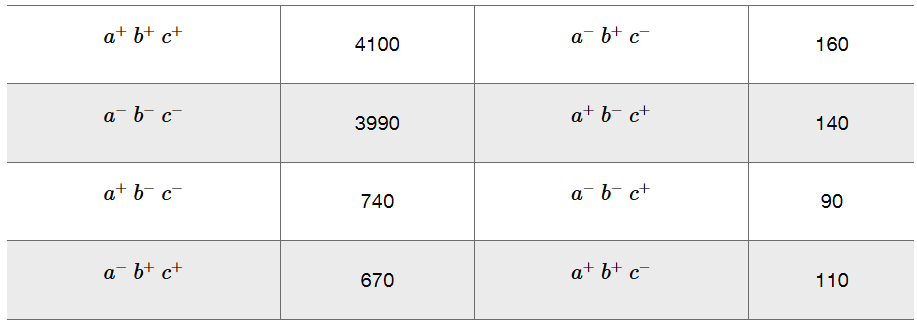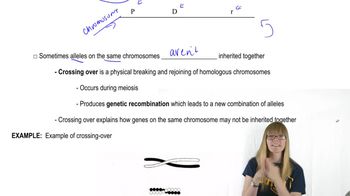Describe what is meant by the term site-specific recombination as used in identifying the processes that lead to the integration of temperate bacteriophages into host bacterial chromosomes during lysogeny or to the formation of specialized transducing phage.
Table of contents
- 1. Introduction to Genetics51m
- 2. Mendel's Laws of Inheritance3h 37m
- 3. Extensions to Mendelian Inheritance2h 41m
- 4. Genetic Mapping and Linkage2h 28m
- 5. Genetics of Bacteria and Viruses1h 21m
- 6. Chromosomal Variation1h 48m
- 7. DNA and Chromosome Structure56m
- 8. DNA Replication1h 10m
- 9. Mitosis and Meiosis1h 34m
- 10. Transcription1h 0m
- 11. Translation58m
- 12. Gene Regulation in Prokaryotes1h 19m
- 13. Gene Regulation in Eukaryotes44m
- 14. Genetic Control of Development44m
- 15. Genomes and Genomics1h 50m
- 16. Transposable Elements47m
- 17. Mutation, Repair, and Recombination1h 6m
- 18. Molecular Genetic Tools19m
- 19. Cancer Genetics29m
- 20. Quantitative Genetics1h 26m
- 21. Population Genetics50m
- 22. Evolutionary Genetics29m
5. Genetics of Bacteria and Viruses
Bacteriophage Genetics
Problem 13
Textbook Question
Two theoretical genetic strains of a virus (a⁻b⁻c⁻ and a⁺b⁺c⁺) were used to simultaneously infect a culture of host bacteria. Of 10,000 plaques scored, the following genotypes were observed. Determine the genetic map of these three genes on the viral chromosome. Decide whether the interference was positive or negative.

 Verified step by step guidance
Verified step by step guidance1
Step 1: Begin by identifying the parental genotypes and recombinant genotypes. The parental genotypes are the most frequent ones observed in the data, which are a⁺b⁺c⁺ (4100 plaques) and a⁻b⁻c⁻ (3990 plaques). The remaining genotypes are recombinants.
Step 2: Calculate the recombination frequencies between each pair of genes. To do this, group the recombinant genotypes based on single crossovers between two genes while keeping the third gene constant. For example, to calculate the recombination frequency between 'a' and 'b', sum the plaques for genotypes that involve a crossover between 'a' and 'b' (e.g., a⁺b⁻c⁺ and a⁻b⁺c⁻), then divide by the total number of plaques (10,000). Repeat this for 'b' and 'c', and 'a' and 'c'.
Step 3: Use the recombination frequencies to determine the relative distances between the genes. The recombination frequency is proportional to the genetic distance in map units (1% recombination = 1 map unit). Arrange the genes in an order that minimizes the total map distance.
Step 4: Check for double crossovers to confirm the gene order. Double crossovers are the least frequent genotypes observed. For example, a⁺b⁻c⁻ and a⁻b⁺c⁺ are likely double crossover genotypes. Verify that the gene order determined in Step 3 is consistent with the observed double crossover frequencies.
Step 5: Determine whether interference is positive or negative. Calculate the coefficient of coincidence (COC) as the ratio of observed double crossovers to expected double crossovers. Interference (I) is then calculated as I = 1 - COC. If I > 0, interference is positive; if I < 0, interference is negative.
 Verified video answer for a similar problem:
Verified video answer for a similar problem:This video solution was recommended by our tutors as helpful for the problem above
Video duration:
3mPlay a video:
Was this helpful?
Key Concepts
Here are the essential concepts you must grasp in order to answer the question correctly.
Genetic Mapping
Genetic mapping is the process of determining the relative positions of genes on a chromosome. It involves analyzing the frequency of recombination between genes during meiosis, which helps to establish their order and distance from one another. In this context, the observed genotypes from the viral plaques will be used to infer the arrangement of the genes a, b, and c on the viral chromosome.
Recommended video:
Guided course

Mapping Overview
Recombination Frequency
Recombination frequency is a measure of how often two genes are separated during the formation of gametes due to crossing over. It is calculated by dividing the number of recombinant offspring by the total number of offspring. This frequency is crucial for constructing genetic maps, as it provides insight into the physical distance between genes; closer genes have lower recombination frequencies.
Recommended video:
Guided course

Recombination after Single Strand Breaks
Interference
Interference refers to the phenomenon where the occurrence of one crossover event in a region of a chromosome affects the likelihood of another crossover occurring nearby. Positive interference means that one crossover reduces the chance of another, while negative interference indicates that one crossover increases the likelihood of another. Understanding interference is essential for interpreting the genetic map and the distribution of genotypes observed in the experiment.
Recommended video:
Guided course

RNA Interference

 3:44m
3:44mWatch next
Master Plaques and Experiments with a bite sized video explanation from Kylia
Start learningRelated Videos
Related Practice
Textbook Question
457
views
